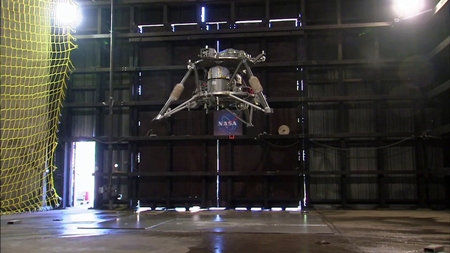A next-generation, advanced robotic lander prototype called as the "MightyEagle" is being developed at NASA's Marshall Space Flight Center. The project is being directed by NASA's Planetary Science Division of the Science Mission Directorate. Engineer Cindy Stemple guides the Robotic Lander Development Project as the flight control commander.
 The robotic lander prototype dubbed "MightyEagle" by the development team at the Marshall Center hovers in a U.S. Army propulsion test facility on Redstone Arsenal. Testing of the lander prototype will continue all summer.
The robotic lander prototype dubbed "MightyEagle" by the development team at the Marshall Center hovers in a U.S. Army propulsion test facility on Redstone Arsenal. Testing of the lander prototype will continue all summer.
Cindy Stemple and her team have spent nearly two years in designing and testing the prototype. They have partnered with the Von Braun Center for Science and Innovation and the Johns Hopkins University's Applied Physics Laboratory. The Von Braun Center includes Dynetics and Teledyne Brown Engineering.
The project aims to develop a small, inexpensive and smart lander for landing on near-Earth asteroids, the moon and other bodies in space. The 4' tall prototype with a tripod-like construct weighs around 700 lbs and has a diameter of 8'. The team is performing studies on novel thermal management techniques and systems for protecting the space-craft from harsh sunlight and bone-chilling cold. Temperature on the lunar surface can go down to as low as -279°F during the night and as high as 260°F during the day.
The project team is testing the prototype through a closed-loop, free-flight, autonomous test runs, when the "MightyEagle" is made to hover between a height of 6' and 16' in a propulsion test facility of the U.S. Army on the Redstone Arsenal. The team has performed over 160 tests on a compressed air fuelled "cold-gas" version and a peroxide-fueled "warm-gas" version prototype.
Further testing is to be performed outdoors on the Redstone Arsenal test range, where the lander would be subjected to complex flight tests involving horizontal, ascent, and descent maneuvers. The project would lead to the development of new multipurpose, strong automated spacecrafts for exploring the solar system.